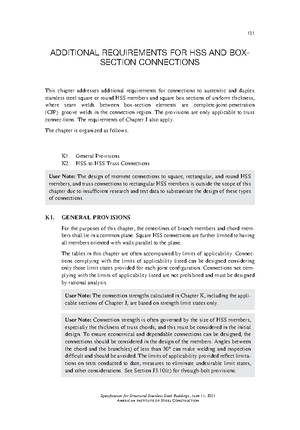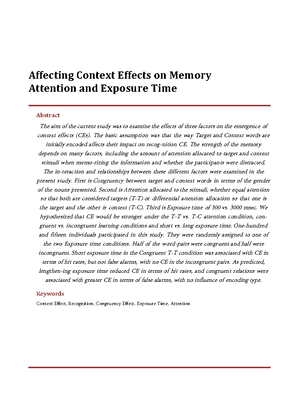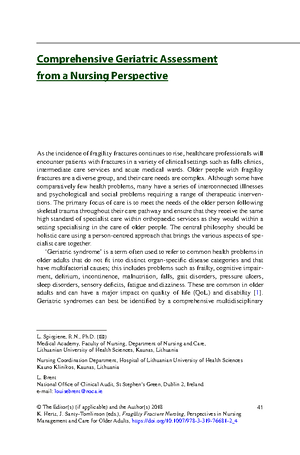- Information
- AI Chat
Evaluation of the Structure and its Components
Scene Design (THEA 3267)
Columbus State University
Preview text
Evaluation of the Structure and its Components
This chapter addresses the evaluation of the structure and its components for the service-ability limit states of deflections, drift, vibration, wind-induced motion, thermal distortion, and connection slip.
The chapter is organized as follows:
L1. General Provisions L2. Deflections L3. Drift L4. Vibration L5. Wind-Induced Motion L6. Thermal Expansion and Contraction L7. Connection Slip
User Note: Stainless steel is usually specified because of its corrosion resistance or for aesthetic reasons. Section A4 gives minimum alloy requirements for specific service environments. The Commentary lists the information that is typically necessary for appropriate alloy specification. AISC Design Guide 27, 2nd Edition, Structural Stainless Steel, gives further guidance on the assessment and importance of those service environ- ment characteristics in selection of an appropriate alloy and surface finish in order to achieve the design life of the structure.
L1. GENERAL PROVISIONS
Serviceability is a state in which the function of a building, its appearance, maintain- ability, durability, and the comfort of its occupants are preserved under typical usage. Limiting values of structural behavior for serviceability (such as maximum deflec- tions and accelerations) shall be chosen with due regard to the intended function of the structure. Serviceability shall be evaluated using applicable load combinations.
User Note: Serviceability limit states, service loads, and appropriate load combi- nations for serviceability considerations can be found in ASCE Minimum Design Loads and Associated Criteria for Buildings and Other Structures (ASCE/SEI 7), Appendix C, and its Commentary. The performance requirements for service- ability in this chapter are consistent with ASCE/SEI 7, Appendix C. Service loads are those that act on the structure at an arbitrary point in time and are not usually taken as the nominal loads. Reduced stiffness values used in the direct analysis method, described in Chapter C, are not intended for use with the provisions of this chapter.
129
Specification for Structural Stainless Steel Buildings, June 11, 2021
L2. DEFLECTIONS
Deflections in structural members and structural systems shall be limited so as not to impair the serviceability of the structure. Deflections shall be determined for the load combination at the relevant service- ability limit state. Unless a more exact method is used, standard structural theory is permitted for estimating the deflection of elastic beams, except that the modulus of elasticity shall be replaced with the reduced modulus of elasticity, Er, determined in accordance with Equation L2-1:
E
E E
r = st + sc 2
(L2-1)
where Esc = secant modulus corresponding to the maximum compressive stress in the cross section, which may be determined in accordance with Appendix 7, Equation A-7-5, ksi (MPa) Est = secant modulus corresponding to the maximum tensile stress in the cross section, which may be determined in accordance with Appendix 7, Equation A-7-5, ksi (MPa)
User Note: Replacing the modulus of elasticity by the reduced modulus provides accurate predictions of the deflection when the maximum stress in the cross sec- tion does not exceed 65% of Fy. At higher levels of stress, the method becomes very conservative. Table User Note L2 gives the secant modulus for common types of stainless steel at a maximum stress in the cross section equal to 0, which may be con- servatively adopted in preliminary estimates of deflection.
TABLE USER NOTE L2.
Secant Modulus
Stainless Steel ksi (MPa)Fy, ksi (MPa) ES,
Austenitic
S30400 and S31600 30 (205) 25,800 (177 000) S30403 and S31603 25 (170) 25,400 (175 000)
Duplex
S32101, S32202, S32205, and S82011 65 (450) 28,300 (195 000) S32304 58 (400) 28,200 (194 000)
L3. DRIFT
Drift shall be limited so as not to impair the serviceability of the structure.
Sect. L3.] DRIFT
131
Specification for Structural Stainless Steel Buildings, June 11, 2021
FABRICATION AND ERECTION
This chapter addresses requirements for fabrication and erection documents, fabrication, and erection.
The chapter is organized as follows:
M1. Fabrication and Erection Documents M2. Fabrication M3. Erection
M1. FABRICATION AND ERECTION DOCUMENTS
Fabrication and erection documents are permitted to be prepared in stages. Fabri- cation documents shall be prepared in advance of fabrication and give complete information necessary for the fabrication and alloy traceability of the component parts of the structure, including the location, type, and size of welds and bolts. The necessary treatment for bimetallic interface connections between the stainless steel and other steel alloy components must be specified. Erection documents shall be prepared in advance of installation and give information necessary for erection of the structure. Fabrication and erection documents shall clearly distinguish between shop and field welds and bolts. They shall clearly identify pretensioned and slip-critical bolted connections. Fabrication and erection documents shall be made with due regard to speed and economy in fabrication and erection.
M2. FABRICATION
- Identification
Hard stamped, punched, or drilled marks are not permitted for stainless steel. Soft or low stress stamps, or stamped metal tags attached by stainless steel wire, may be used. Temporary color coding or marking with paint, crayon, ink stencil, or similar approved chloride and sulfide free marking products is permitted during fabrication, but shall be fully removed prior to on-site welded fabrication and project completion.
- Handling and Storage
Contractors shall be required during all stages of handling, shipment, storage, and erection to take preventative measures to avoid surface finish damage, free iron, or other material contamination due to exposure to steel cutting or grinding, and other potential sources of damage that may adversely affect appearance or performance. Contact with chemicals and acids, including dyes, glues, adhesive tape, hydrochloric acid, chloride containing cleaning products, and undue amounts of oil and grease shall be avoided. If it is necessary to use them, their suitability and the maximum duration of exposure shall be determined.
132
Specification for Structural Stainless Steel Buildings, June 11, 2021
User Note: See AISC Design Guide 27, 2nd Edition, Structural Stainless Steel, and ASTM A967/A967M for information on chemical passivation methods for removing embedded metals and other surface contamination from stainless steels to restore corrosion resistance. Deeply embedded metal contamination may need to be removed by chemical descaling or another acceptable method in accordance with ASTM A380/A380M.
- Cambering, Curving, and Straightening
Mechanical means, such as stretcher- or tension-leveling, may be specified to intro- duce or correct camber, curvature, and straightness. Stretcher- or tension-leveling tolerances shall be specified in accordance with the applicable general requirements in the ASTM standards listed in Section A3 for the product or as agreed in the con- tract documents. If the temperature and exposure time cannot be carefully controlled, warm form- ing or straightening shall not be permitted. Unless otherwise indicated by the alloy producer or when there will be solution annealing after forming, the maximum austenitic stainless steel temperature for warm forming or straightening shall be 900 °F (480°C). For duplex stainless steel the maximum allowable temperature for warm forming or straightening is 750°F (400°C). If the working temperature exceeds 750 °F (400°C), a full solution anneal and rapid quench of the duplex stainless steel shall be required. Annealing colors and oxide scales shall be completely removed in accordance with ASTM A380/A380M.
User Note: Duplex stainless steels have very low strength at annealing tempera- tures, and distortion is likely during annealing.
- Cutting
Oxyacetylene cutting shall not be used for cutting stainless steel without a powder fluxing technique and is strongly discouraged. If it is used, then the resulting surface shall be cleaned in accordance with AWS D1.6/1, clause 7, Weld Cleaning. Shearing, sawing, abrasive cutting, water jet cutting, and thermal cutting by plasma or laser are permitted for structural stainless steel. Thermal cutting shall not be used unless at least 8 in. (3 mm) of material is mechanically removed from any thermally cut edge. Oxyacetylene torch cutting shall not be used. Notches or gouges on cut surfaces (edges) not exceeding z in. (2 mm) for materials less than s in. (16 mm) in thickness or 10% of the material thickness for materials s in. (16 mm) or greater need not be repaired unless specified by the engineer of record (EOR) or contract specifications. If fatigue service is anticipated, the EOR shall establish limits for notches and gouges in areas with stress concentrations.
FABRICATION [Sect. M2.
134
User Note: Weld distortion is generally greater in stainless steel than in other steel alloys, particularly with austenitic stainless steel which has a higher coef- ficient of thermal expansion. Heat input and interpass temperatures should be controlled to minimize distortion and avoid potential metallurgical problems, and follow an appropriate weld procedure approved by the EOR.
Bimetallic interfaces in welded joints combining stainless steels with other steel alloys shall be protected from galvanic corrosion by a waterproof coating suitable for the service environment and intended maintenance frequency, unless the environ- ment has consistently low humidity levels and no exposure to moisture from rain, fog, immersion, high humidity, and condensation. The coating shall consist of an epoxy coating, metal primer, and paint system, or other durable waterproof coating that is applied to the other steel alloy and extends over the weldment onto the stain- less steel to a distance of at least 2 in. (50 mm). If stainless steel will be painted, the passive film shall be abrasively or chemically removed immediately before application of the metal primer or a suitable etchant primer shall be used.
User Note: The passive film on stainless steel fully reforms after 24 hours and its presence will cause poor paint adherence.
- Bolted Construction
Parts of bolted members shall be pinned or bolted and rigidly held together during assembly. Use of a drift pin in bolt holes during assembly shall not distort the metal or enlarge the holes. Poor matching of holes shall be cause for rejection. Machined, drilled, or water jet cut holes are permitted. Thermal cutting of holes by plasma or laser shall not be used unless at least 8 in. (3 mm) of material is mechani- cally removed from any cut edge. Gouges shall not exceed a depth of z in. (2 mm). If fatigue service is anticipated, the EOR shall establish limits for notches and gouges in areas with stress concentrations. Fully inserted finger shims, with a total thickness of not more than 4 in. (6 mm) within a joint, are permitted without changing the strength (based upon hole type) for the design of connections. The orientation of such shims is independent of the direction of application of the load. The use of bolts shall conform to the requirements of Section J3.
User Note: The lubrication of bolts is beneficial but corrosion arising from con- tamination of pre-applied lubrication by chloride salts, industrial pollutants, or other corrosive substances and metallic particles during storage may occur. This contamination could cause corrosion that might not otherwise occur, and may lead to premature failure. Application of lubricants shortly before use is advisable.
FABRICATION [Sect. M2.
135
Specification for Structural Stainless Steel Buildings, June 11, 2021
- Compression Joints
Compression joints that depend on contact bearing as part of the splice strength shall have the bearing surfaces of individual fabricated pieces prepared by milling, saw- ing, or other equivalent means.
- Dimensional Tolerances
Dimensional tolerances for fabrication shall be in accordance with AISC Code of Standard Practice for Structural Stainless Steel Buildings Chapter 6. Dimensional tolerances for structural shapes shall be specified in accordance with Table A3.
- Finish of Column Bases
Column bases and base plates shall be finished in accordance with the following requirements: (a) Steel bearing plates 2 in. (50 mm) or less in thickness are permitted without mill- ing provided a smooth and notch-free contact bearing surface is obtained. Steel bearing plates over 2 in. (50 mm) but not over 4 in. (100 mm) in thickness are permitted to be straightened by pressing or, if presses are not available, by mill- ing for bearing surfaces, except as stipulated in subparagraphs (b) and (c) of this section, to obtain a smooth and notch-free contact bearing surface. Steel bearing plates over 4 in. (100 mm) in thickness shall be milled for bearing surfaces, except as stipulated in subparagraphs (b) and (c) of this section. (b) Bottom surfaces of bearing plates and column bases that are grouted to ensure full bearing contact on foundations need not be milled. (c) Top surfaces of bearing plates need not be milled when complete-joint-penetra- tion groove welds are provided between the column and the bearing plate.
- Holes for Anchor Rods
Holes for anchor rods shall be cut in accordance with Section M2.
- Drain Holes
When water can collect inside HSS or box members, either during construction or during service, the member shall be sealed, provided with a drain hole at the base, or otherwise protected from water infiltration.
- Faying Surfaces for Slip-Critical Bolted Connections
Faying surfaces of slip-critical bolted connections shall be grit-blasted and shall have a defined surface roughness, as specified in Table M2, using either Rz or Rt. Every production faying surface does not require surface roughness inspection; however, a blast process shall be qualified to produce the required surface roughness and pro- duction faying surfaces shall require intermittent inspection. SSPC PA 17 shall be
Sect. M2.] FABRICATION
137
Specification for Structural Stainless Steel Buildings, June 11, 2021
- Alignment
No permanent bolting or welding shall be performed until the affected portions of the structure have been aligned as required by the construction documents.
- Fit of Column Compression Joints and Base Plates
Lack of contact bearing not exceeding a gap of z in. (2 mm), regardless of the type of splice used (partial-joint-penetration groove welded or bolted), is permitted. If the gap exceeds z in. (2 mm), but is equal to or less than 4 in. (6 mm), and if an engineering investigation shows that sufficient contact area does not exist, the gap shall be packed out with nontapered steel shims. Shims shall be made of a stainless steel with similar or better durability than that of the structure.
- Field Welding
Surfaces in and adjacent to joints to be field welded shall be prepared as necessary to assure weld quality. This preparation shall include surface preparation necessary to correct for damage or contamination occurring subsequent to fabrication.
- Cleaning after Erection
Contamination of stainless steel by contact with free iron shall be avoided. Other steel alloy brushes, wool, scrapers, or other products shall not be used. To limit surface contamination, the stainless steel shall either be protected by removable plastic film or another barrier, and final cleaning shall be performed after completion of the structure in accordance with ASTM A967/A967M. Cleaning procedures shall be appropriate for the material, surface finish, function of the component, and cor- rosion risk, and shall not contain chlorides or hydrochloric acid. The method, level, and extent of cleaning shall be specified.
User Note: Some stainless steel products like bar, HSS, and pipe contain higher levels of sulfur. Chemical descaling by the manufacturer removes surface sulfides. If the surface finish is subsequently disturbed by finishing, machining, welding, or some other process that removes metal, additional sulfides will be exposed and the stainless steel will be more susceptible to corrosion. In corrosive environments, chemical passivation in accordance with ASTM A967/A967M is advisable after the last processing step that disturbs the surface to remove surface sulfides and achieve maximum corrosion resistance.
Sect. M3.] ERECTION
Evaluation of the Structure and its Components
Course: Scene Design (THEA 3267)
University: Columbus State University

- Discover more from:













